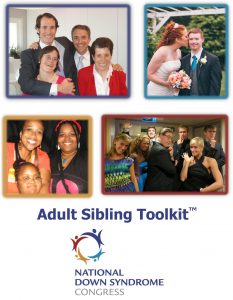Tweens & Teens

FREE Webinar – How to create a special needs plan
Presented by Phillip Clark, Founder and President of ENABLE Special Needs Planning and sibling to his sister who has Down syndrome.
AAP Health Care Information for Families
You can print a checklist for your child’s age, to take with you to your pediatrician here:
You can also print the Down Syndrome Growth Charts, updated by the CDC in November 2015:
Eye problems and vision disorders are especially common in individuals with Down syndrome.
What is keratoconus?
Keratoconus, often referred to as “KC”, is an eye condition in which the cornea weakens and thins over time, causing the development of a cone-like bulge and optical irregularity of the cornea. Keratoconus can result in significant visual loss and may lead to corneal transplant in severe cases. Although somewhat rare in the general population, KC affects between 5–15% of people with Down syndrome and can impact their ability to function at their highest level.


How is KC diagnosed & treated?
In the general population, KC is often under-diagnosed because the patient may be told that vision changes are due to astigmatism. Only as the disease progresses, requiring frequent changes in the eyeglass or contact lens prescription, does it become apparent that a medical condition is responsible. For patients with Down syndrome, a missed or delayed diagnosis can be even more debilitating. They may not complain about changes in vision until the disease is advanced. In addition, it is believed that eye rubbing can make KC worse. People with DS often have a predisposition to allergic conditions, causing them to rub their eyes frequently and likely worsening their KC. For these reasons, it is important for caregivers to schedule regular eye exams beginning in infancy, and to screen for KC during the teen and early adult years.
Corneal cross-linking (CXL) or iLink™ is an FDA-approved procedure for the treatment of progressive KC, using ultraviolet (UVA) light and eye drops containing Vitamin B. Although not without possible risks, iLink™ is a safe, single treatment procedure that takes about an hour and can be performed in a doctor’s office.
How do I locate a provider who performs corneal cross-linking?
Living With Keratoconus has a wonderful tool for finding providers near you.
More Info on KC & DS More Info on iLink
Information provided by 
Puberty starts at about the same age for teens with Down syndrome as for other young people. Get ready for mood swings, crushes, feeling confused, and tiredness from your loved one during the time of puberty. Your child will have many of the same sexual feelings as other teens. Teens with Down syndrome have the same social needs as other teens. Most will want to date, make friends, and have close relationships. You can help prepare your child to do these things. Teach your child about proper social skills and behavior.
What are some things my child is going to experience as a tween/teen?
Puberty is very similar in children with Down syndrome as other teens. Encourage your teen to take part in school and community activities. Give your teen the chance to form healthy friendships. Friends can help make your teen feel happy and like they are part of the group. Support your teen’s interests, such as in art or music.
- Start talking about proper hygiene.
- Tech how to use deodorant and other body odder products.
- Tech females how to use feminine products.
- Let them know how the body is going to start changing
- Start talking about the mental and emotional changes they will start to go through.
- Make sure you are aware if you start to see a drastic change in emotions.
- If you start to notice your loved one is becoming depressed, losing appetite, or behavior regression try consulting with a therapist so they can work with your child to better understand themselves during this time.

What if my teen/tween with Down syndrome wants to have a romantic relationship?
It is encouraged that individuals with Down syndrome have romantic relationships with others, but you as a parent/caregiver can set the boundaries that need to be respected. As your loved one matures, they may be attracted to other people in new ways. This could mean they spend time thinking about a person or imagining spending time with them.
- Start early to prepare your child for healthy adult relationships.
- Discuss birth control in a clear, simple way.
- Teach safer-sex practices to prevent sexually transmitted infections.
- Teach respect for his or her body and the bodies of others.
- Talk openly about your morals and beliefs.
- Start talking about romantic relationships.
- Teach them how to go on dates and what is appropriate and not appropriate.
- Start asking questions like: How well should you get to know someone before asking them out? When can you start holding hands? How soon is too soon for your first kiss?

Gabi and Nick who met at NDSC 47th National Convention in Pittsburgh
Helpful Resources
You can also check out Terri Couwenhoven’s podcast through Children’s Hospital Boston hosted by NDSC past president Kishore Vellody MD on sexuality and relationships in teens and adults.
Puberty and Sexuality Issues, Part 1, Puberty and Sexuality Issues, Part 2
Boston Children’s Hospital provides insight into parenting and behavioral challenges in children and teens that you may run into. Behavior and down Syndrome: A Practical Guide for Parents
Teens and Tweens with Down syndrome use the internet and social media websites just as much as their typical peers. Using the internet has lots of positive benefits, but it’s important to stay safe too. As a parent, you can help your child understand how to stay safe online and on social media platforms.
What are some ways to keep my child safe on the internet?
- Set up parental controls- this allows you to know what your child is seeing and doing and making sure that they are not visiting an unwanted website.
- Review their browsing history regularly
- Disable tagging locations- this is important because if your child uploads a picture you don’t want their current location to be visible for everyone.
- Teach your child that information shared on the internet is not private.
- Review information that should not be shared (personal details, passwords, credit card numbers).
- Explain the limits to online relationships. Emphasize that it is NOT ok when someone requests personal information, photos, location, etc.
- Encourage your child not to delete messages, including those that are hurtful or don’t feel right. Tell them to save anything that they’re not sure about and set aside time to review the messages together.
Down Syndrome Australia provides resources about social media and online safety and how it is very important to know how to keep your loved one safe when they are on the internet. This includes whether you’re on a computer, a tablet such as an iPad, or on your phone.
In 2011, Dr. Brian Skotko, a regular speaker for the NDSC Annual Convention, conducted a study at Children’s Hospital Boston and found “among siblings ages 12 and older, 97 percent expressed feelings of pride about their brother or sister with Down syndrome and 88 percent were convinced they were better people because of their sibling with Down syndrome.
How should I work with my children who don’t have Down syndrome?
- Make sure your children know they are appreciated for the things they help with when it comes to their sibling with down syndrome.
- Let your other children know that their sibling with down syndrome isn’t receiving any special treatment when it comes to discipline, let them know that each form of discipline is unique to them.
- Make sure you make your other children feel just as special as you do with your child with Down syndrome, this is hard to juggle, but just taking them out by themselves and showing them they are special will mean a lot to them.
How do I explain to my child with Down syndrome that they don’t get the same freedoms as their siblings?
As your children get older you as a parent will automatically start to give them more freedom. This can be going to the movies alone, driving a car, hanging out with friends, etc. Your child with Down syndrome will start to see that they are not getting the same freedoms and will become frustrated. Try to be accommodated. Recommend going to the movies with them or ask them if it is okay that their friends come to your house to hang out so you can supervise. You can also recommend an older sibling take them places so they can feel “cool” getting to go places alone. Small things like this can make a big difference.
The Down syndrome pregnancy website has an excellent blog that gives insight into the relationships your children have with one another when becoming adults. A Siblings Perspective on Down Syndrome.
NDSC’s Adult Sibling Toolkit
Just for adult siblings, this toolkit is designed to jump-start conversations with parents about becoming more involved in their brother or sister’s life.
Siblings can use this information to be an effective advocate and perhaps, caregiver after their parents are no longer able.
Visit our Adult Sibling Program page to downloaded information

When Your Child Engages in Difficult Behavior
by David Pitonyak, Ph.D., Blacksburg, VA
Editor’s note: David Pitonyak is a nationally-recognized expert and popular speaker on the subject of Positive Behavior Support. He gave permission to reprint this article. Check out www.dimagine.com to see more of his work.
Several years ago I was asked to speak to a group of parents in Vermont. The title of the presentation was “Supporting Children with Special Needs.” Five minutes into my talk, a parent stood up and interrupted me. She insisted that I stop referring to her daughter as someone with “special needs” (I had been using the term a lot).
“My daughter does not have special needs,” she said. “My daughter has the same needs as anyone else. She has a need to live at home with her family. She has the need for a good education, friends, fun, and a supportive family. Sometimes you professionals – in your efforts to provide special services to people – forget the ordinary, everyday things that people need.”
She must have known that I was embarrassed. I’m sure I turned 80 shades of red as I muttered through the rest of my presentation. After it was over, she put her hand on my shoulder and said, “You’ll be fine.”
As awkward as I felt about the evening, I felt grateful too. I learned one of the most important lessons I have ever learned as a professional. Sometimes, in our efforts to provide “special” services to people, we often forget the ordinary things people need every day: friends, family, interesting and fun things to do, safety and security, and a chance to make a contribution to the larger community. (In short, a chance to belong).
What follows are 10 things to remember if your child, because he or she exhibits difficult behaviors, is at risk of not belonging. If you don’t have the time or energy to read one more word, remember these two ideas:
Taking care of yourself is one of the most important things you can do. If you don’t, it will be very difficult to take care of anyone else.
Remember that your child’s problem behavior(s) has meaning. Finding out what your child needs is the first step in supporting your child, and the people who love your child, to change.
1. Be Mom and Dad first
Chris Heimerl writes, “Of all the hats you must wear: advocate, care provider, therapist, teacher, the most important is Mom and Dad. Your love is the most powerful treatment any of us can imagine. If all the other stuff you have to do first interferes with being a parent, stop. Someone else can do some of the other necessary stuff, but nobody else can be Mom and Dad.”
2. Think of challenging behaviors as “messages”
Difficult behaviors result from unmet needs. In a sense, difficult behaviors are “messages” which can tell us important things about your child and the quality of his or her life. Here are some examples of the kinds of “messages” your child may be conveying with their behavior:
- “I’m lonely.” — Michael’s brother was invited over to a friend’s house to watch television. Michael is never invited to the homes of children because he goes to a “special” school 35 miles from his neighborhood. Michael has no friends to play with.
- “I’m bored.” — Roberta’s sister is a doctor at the local hospital. She has her own house and is her parents’ pride and joy. Roberta works all day at a sheltered workshop where she packages plastic forks and knives. She lives at home and is tired of packaging. She wants to get a real job. Roberta’s case manager says she daydreams too much.
- “I have no power.” — John likes to sit down on the sidewalk when the bus arrives to take him to school. His mother becomes very angry and tells him that there will be no dessert when he gets home. John laughs when the bus driver threatens him with time-out.
- “I don’t feel safe.” — Conrad uses a wheelchair and is not able to defend himself from attacks. One of the people in his day program can be aggressive and Conrad worries that he will be hurt.
- “You don’t value me.” — Gloria has a “severe reputation.” People from all over the state have heard stories about her terrible tantrums. No one knows that she is a very caring person who worries about her father’s health. The only part of Gloria people pay attention to is her problem behaviors.
- “I don’t know how to tell you what I need.” — June did not know how to use words or signs to let other people know what she was thinking. She lives at home with her parents where she has learned that the best way to be “seen” is to bite your arms. It hurts, but it is the only thing that “works.”
- “My ears hurt.” — Walter hit his ears with his fists. His job coach wanted it to stop and wrote a behavior plan for “not hitting.” Weeks later, at a scheduled doctor’s appointment, it was learned that Walter had a low-grade ear infection. Antibiotics cleared up the infection and Walter stopped hitting his ears.
Obviously, there are many needs that your child might be expressing through his or her behavior. A single behavior can “mean” many things. The important point is that difficult behaviors do not occur by accident or because someone has a disability. Difficult behaviors are expressions of real and legitimate needs. All behavior, even if it is self-destructive, is “meaning-full.”
Ask yourself, “Is my vision for my child similar to the vision I have for my other children (or the vision other parents have for their children)? When I think about what my child needs, do I focus on disability-related needs, or do I think about things like friendships, fun, a sense of belonging?”
3. Learn about person-centered planning
In the book, A Little Book About Person-Centered Planning, authors Connie Lyle O’Brien, John O’Brien, and Beth Mount describe the powerful differences between traditional approaches and person-centered planning. Unlike traditional approaches to planning, which ask questions like, “What’s wrong with you?” and “How can we fix you?” person-centered planning focuses on questions like, “What are your capacities and gifts, and what supports do you need to express them?” and “What works well for you and what does not?” and “What are your visions and dreams of a brighter future and who will help you move toward that future?” Describing the roots of person-centered planning, Lyle O’Brien, O’Brien, and Mount write (1998): “Person-centered planning did not ignore disability, it simply shifted the emphasis to a search for capacity in the person, among the person’s friends and family, in the community, and among service workers. A person’s difficulties were not relevant to the process until how the person wanted to live was clear. Then it was necessary to imagine, and take steps to implement creative answers to this key question, “What particular assistance do you need because of your specific limitations (not labels) in order to pursue the life that we have envisioned together?”
4. Don’t assume anything
It is easy to make the mistake of underestimating your child’s potential because of his or her labels or because he has failed to acquire certain skills. This is a tragic mistake. I have worked in the field for 15 years and I am less confident in my ability to predict how much a person understands or how much he will be able to accomplish with every passing day. For example, the new AAMR definition of mental retardation states that an individual’s success or failure in life is determined by the quality of his supports rather than a missing gene or “faulty” body chemistry. In short, professionals like me used to doom people because of an arbitrary diagnosis. What some of us have finally woken up to is the fact that nothing dooms people more than a lack of support.
You can speak volumes to your child about his self-worth by always including your child in conversations and explaining things as clearly as you can. Even if you doubt your child’s ability to understand your words, know that at the very least your child will understand the tone of your voice; make sure it reflects dignity and respect as often as you can. Never speak about your child as if he was not in the room.
5. Remember that relationships can make all the difference in the world
Loneliness may be the most significant disability your child will ever face. Many people with disabilities, young and old, live lives of extraordinary isolation. Some depend entirely upon their families for support. A brother or sister or mom or dad is the only source of company. Friends are often absent altogether. All too often, the only relationships people have are with paid staff. Although staff can offer a great deal, they change jobs frequently or take on new responsibilities. The resulting instability can be devastating to someone who is fundamentally alone.
Involve your child with other children at a young age (children with and without disabilities). It is easier to learn about the importance of relationships when their importance has been clear over a lifetime.
It’s easier to be a friend when you have friends that know something about friendship. Insist that your child be included in regular classrooms. Inclusion is a powerful way to build relationships.
And don’t let anyone fool you into thinking that inclusion of children with disabilities in regular classrooms is a bad idea. Doing it poorly is a bad idea. Doing it well is good for all children.
Make a commitment to learning more about personal futures planning and other person-centered approaches to planning for your child’s future. Do it today!
6. Help your child to have more fun
Fun is a powerful antidote to problem behaviors. Count the number of things your child enjoys, the number of places she likes to go. Compare this to the number of things other children enjoy, the number of places other children go. Ask yourself, “Is my child having fun? Is she experiencing enough joy? Is this an interesting life?” People with substantial disabilities often live in ghettos of reward. Indeed, it is often this poverty of reward, not a lack of skills, which keeps people separate from other community members.
Sadly, many people with disabilities are put on reward schedules for good behavior. The very few things that they enjoy are used contingently to reinforce compliance (talk about spoiling a good thing).
Help your child to add to her list of interesting (and really fun) things to do.
Spend time in regular community places where people hang out. Make fun a goal.
7. Take care of yourself, take care of your partner, and join with other parents to support each other
Many parents suspend their own dreams and aspirations the day their child is born. They adopt the identity of “parent of a child with a disability,” putting their own needs on hold like a videotape that can resume at the touch of a button. Many parents feel isolated because their child has a disability. They feel obligated to suspend their relationships with other people because the work of parenting their child seems all-consuming, or they feel that other people will have difficulty understanding their child’s disability. There is a deep fear of rejection. As one parent put it, “It is better to be alone than to feel my child’s hurt when he is rejected.”
Chris Heimerl writes: “Take care of yourself, take care of your partner and join with other parents to take care of each other. Before you became a parent you were a partner in a relationship that had enough love, nurturing, and respect to want kids. Don’t lose sight of that relationship. Before you were a partner, you were a person that someone found attractive, vital, and loving. Don’t lose sight of that person.”
Get connected and stay connected with parents of children with and without disabilities. Join organizations made up of parents who fight for the inclusion of their children in every aspect of community life.
Remember that the vast majority of innovations that have taken place in our service delivery system happen because parents and their children have become dissatisfied with “what is.” If you join forces with other parents you can make a significant difference in your child’s life.
Learn about the laws and regulations that help and hurt your child’s inclusion in community life. Speak up whenever your child’s future is at stake. Above all, be respectful of people who disagree with you while remaining steadfast about your beliefs.
8. Help your child to make a contribution to others
Lou Brown has said that the least amount of difference between a child with disabilities and a child without disabilities may be the day that they are born, naked to the world. But then, because of the way our society separates the child with disabilities into “special services,” he or she becomes “different.” Perhaps the most devastating effect of this separation is that the child with a disability does not learn what he or she can contribute to others. In a sad kind of way, the child becomes the “needy one.” Being needy – all the time – is dispiriting. Making a contribution to others – to your family, friends, and the larger community – is good for you. It’s good for the soul. It’s good for the heart, the brain…it’s probably a biological imperative to give. One day we may learn that the world actually revolves on its axis not because of the laws of physics, but because of the love we give to others. As John Bradshaw writes, ” Our identity is the difference about us that makes a difference.”
The real danger, of course, is that if enough people begin to think of you as “needy,” you will begin to believe it too.
We all need to be needed.
It is my experience that people with difficult behaviors especially need to be needed.
Help your child to find a way to make a contribution to others. Start young because learning to give is a lifelong endeavor. Help your child to learn how to support friends (e.g., an invitation to a sleepover, birthday cards, learning to ask, “How are you doing?” or “What’s new?”). Things as simple as helping with household chores or helping out at church can teach your child that she can make a contribution.
9. Instead of ultimatums give choices
If it is 9 p.m. and you are sitting down to read these words, chances are good that you have made hundreds, if not thousands, of choices since 7 a.m. You may have decided to wear blue socks when getting dressed. You may have decided not to wear a heavy sweater, hoping the warmer weather would prevail. You may have decided to skip breakfast, buy unleaded gas, work on a report, clean the garage, take a hike, watch a football game, etc. You may have made more monumental decisions: purchased a house, stopped drinking, decided to re-marry, purchased a major appliance, agreed to surgery, etc. The point is, we humans are decision-making machines.
Many people with disabilities have little or no control over their own lives. Many of the decisions that we take for granted – such as what to wear and whether or not to have a cup of coffee – are made by other people. How would you feel if you lived such a life?
The mistake we make with children and adults with disabilities is we assume that because they don’t always make good decisions about some things they ought not to make decisions about anything.
Always remember that our tendency is to become directive and negative when our children are engaging in problem behaviors. We tend to take control when our children are out of control. Ironically, our children may need more control not less when their behavior is disturbing.
Choice is a powerful alternative to punishment. If your child’s behavior challenges you, help him or her to find more desirable ways to express the needs underlying his or her behaviors. Instead of ultimatums, give choices (e.g., “Bill, I know you’re upset. What would help? Would you like to go for a walk? Or take a ride? That will give you a chance to calm down and then we can talk about what you need?”).
Allow your child to make decisions throughout the day. If he has trouble making choices, find a way to help. Make sure there are at least three desirable outcomes to choose from. As Norman Kunc has said, 1 option = tyranny; 2 options = a dilemma; 3 or more options = a real choice.
Make sure your child is invited to his or her IEP or IHP meetings. It is important that he or she have input whenever possible. This is especially true when a problem behavior is being discussed (imagine how you would feel if people were trying to change your behavior and never stopped to ask you what you think). It is also important that your child be able to say “no.”
If your child does not speak, ask anyway. Suggest that he find a nonverbal way of letting you know what’s needed.
Don’t assume that helping your child to have more choices means letting him do whatever he wishes. Limit setting is an important and fair part of any relationship. The real question is who is setting the limits and why. If limits are imposed upon children without their input, and if the limits are part and parcel of a life in which your child is powerless, even your best advice may be interpreted as one more statement of, “Do it my way or else.”
Expect a general disregard for advice when the person receiving the advice is never heard. Rebellion may be a healthy strategy for someone who is out of power. As Tom Harris put it, “It’s better to have bad breath than no breath at all.”
[Author’s note: I heard the expression, “Instead of ultimatums give choices,” years ago, but I’ll be darned if I remember where. My apologies to the author of this succinct phrase, wherever you are…]
10. Establish a working relationship with a good primary health care professional
Mark Durand has said, “People tend to get immature when they don’t feel well. “How often have you experienced a general decline in your mood, your ability to empathize with the needs of others, when you don’t feel well? When we are sick, we are not ourselves.
Many people who exhibit difficult behaviors do so because they don’t feel well. The sudden appearance of behavior problems may be a signal that your child does not feel well. Illnesses as common as a cold or earache can result in behaviors as inconsequential as grumpiness or as serious as headbanging.
It is important to establish a working relationship with a good primary health care physician. Although this is easier said than done, your child, especially if he has difficulty communicating, will need a doctor who can help him to stay healthy and well.
Remember that physicians, like many other people who grew up in our “separate” society do not always understand (and may even fear) a person with substantial disabilities.
Don’t be afraid of telling your child’s doctor that you don’t understand a recommendation or finding. It is important to get a clear and straightforward answer to all of your questions.
Remember that it is important to go beyond a concept of health as the absence of a disease or illness. “Feeling well” and “being healthy” involves everything from a balanced diet to a good night’s sleep. Help your child to learn about “wellness.”
References
Lyle O’Brien, C., O’Brien, J. & Mount, B. (1998) “Person-Centered Planning has Arrived…or Has It?” In O’Brien, J. & Lyle O’Brien, C. (Eds). A Little Book About Person-Centered Planning. Toronto: Inclusion Press
Stubborn Is
